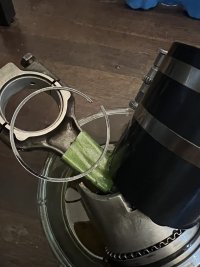Also I'll add that installing rings is a bit of an art. It's easy to mess it up, and particularly easy to mess up those oil rings. You want to knock them in there hard enough to get em in, but not hard enough to break em. The ring compressor has to be square against the block and not cone shaped. How can I describe this? So with the rings in the piston, piston in the bore, compressor tool installed, the oil ring shouldn't be holding the piston up. In other words, the ring compressor should extend below the bottom ring just a little. Like 1/4". Set that whole thing in the bore and square up the compressor with the top of the block. Tap the compressor around on top to make sure it's "seated" squarely against the block. Then start tapping with the handle of a hammer or something. Don't try to drop the whole thing in on one tap. Just try to get it in there one ring at a time. Firm quick taps.
I like that compressor for diesels, but I have not had good luck with shorter pistons with that one. I find it's too easy to not install it straight. This is the type I use with smaller pistons:
Plus, with the "pliers" tool, it lets you better handle the piston and have finer control of the tension you put on the rings. That's just my opinion. Nothing wrong with the one you have, I just like this one better.
Hell, I used to use hose clamps. So, really it probably is just a matter of learning to use the tool.
Also, oil. LOTS OF IT. No such thing as too much. Your floor is already a mess right?



